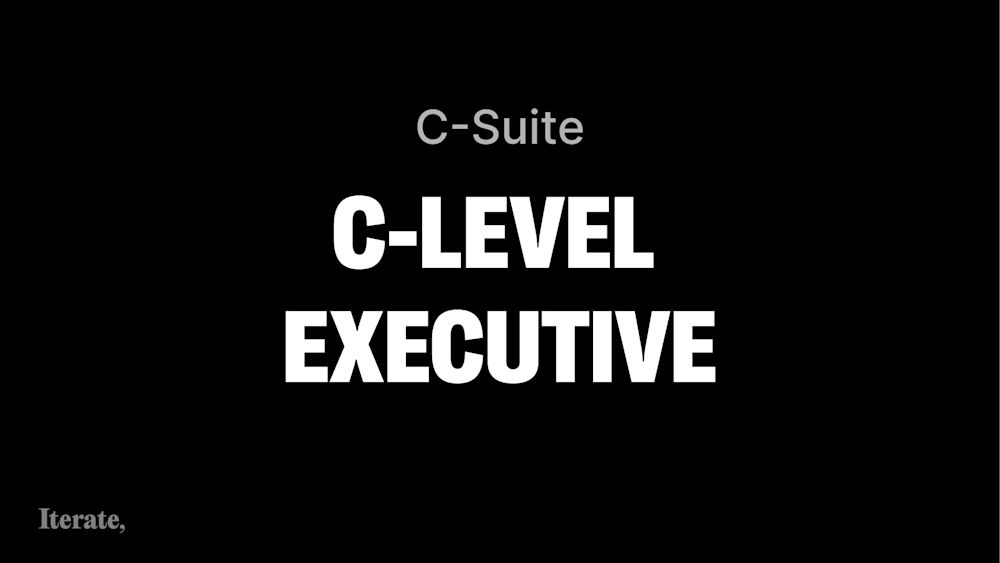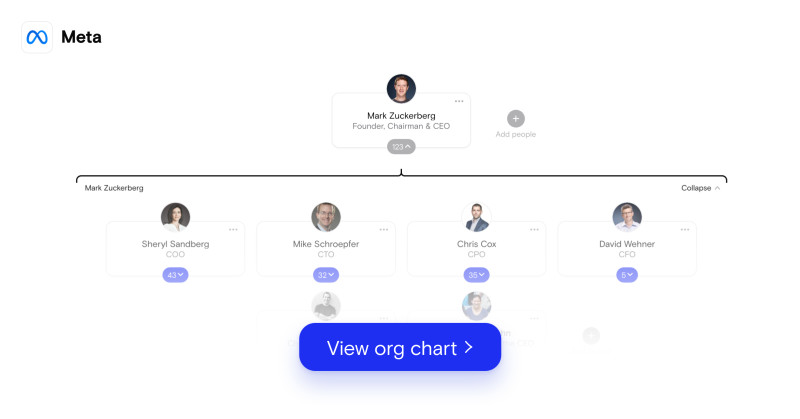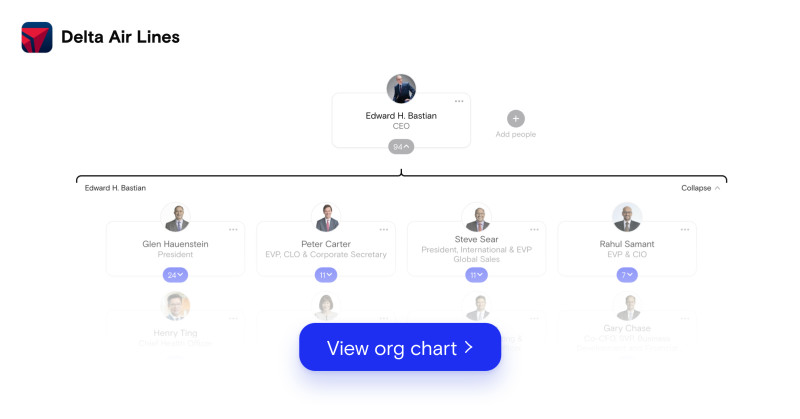Table of contents
A C-level executive is a senior or high-ranking executive at a company. C-level executives head up their respective departments or business units (like Marketing, Finance, or Technology) and are responsible for strategy and decision-making within those teams.

A C-level executive is a senior or high-ranking executive at a company. C-level executives head up their respective departments or business units (like Marketing, Finance, or Technology) and are responsible for strategy and decision-making within those teams.
The C in C-level stands for “Chief.” Executives in this role are often referred to as members of the “C-suite”.
What do C-level executives do?
While their duties sometimes overlap, each C-level executive holds a distinct purpose. C-level executives are responsible for leading their respective departments. They handle strategic planning and delegation within their teams and bring that information back to the CEO and other C-suite members.
At smaller companies, C-level executives are more likely to do hands-on work; at larger corporations, they delegate and manage the processes within their departments. These executives focus on higher-level priorities like developing new strategies and setting long-term goals for the company.
Beyond the CEO, different companies have different C-level titles. For example, a healthcare company might have a Chief Healthcare Officer, while a tech startup is more likely to have a Chief Innovation Officer.
What skills and experience do C-level executives need?
C-level executives need to have specific skills and professional experience to be successful. Data from Gartner TalentNeuron shows that C-suite executives are increasingly expected to have both technical skills and “soft” skills.
C-level skills
The most successful C-level executives are experts in their subject areas and great leaders. If you want to reach the C-suite in your career, here are some important skills to focus on:
- Leadership: First and foremost, C-level executives are leaders. Leadership goes beyond a job title or level. As leadership expert Lance Secretan said: “Great leadership is about human experiences. It's not a formula or a program, it is a human activity that comes from the heart and considers the hearts of others. It is an attitude, not a routine."
- Technical expertise: C-level executives need to be experts in their areas in order to strategically lead their departments.
- Delegation: Knowing how to strategically delegate tasks to different employees based on their respective skillsets is key to a department’s success.
- Change management: The best executives can confidently lead during tumultuous times. They also know when change is needed and how to drive transformation within their organizations.
- Communication: Communication is key to being a strong leader. C-level executives must know how to share, receive, and synthesize information with their employees and the CEO. This includes being an active listener.
- Integrity: Integrity should include honesty, empathy, and authenticity. Strong executives know how to show compassion and understand how different factors impact their teams.
- Time management: Sometimes it feels like there aren’t enough hours in the day. With so many different responsibilities to juggle, C-level executives need to make the most of their time.
C-level experience
Most C-level executives have years of experience in their field, including experience leading teams and even departments. Different companies have different professional experience requirements for C-level executives.
At many large corporations, members of the C-suite have served in Senior Vice President (SVP), Vice President (VP), and even prior C-suite roles at other companies. At smaller companies and startups, on the other hand, the founders of the company often take on C-level titles — sometimes without any prior leadership experience at all.
For example, let’s compare the CEO of Delta with the CEO of Facebook. Delta CEO Edward Bastian became CEO in May 2016 after nearly 18 years with the airline. Before becoming CEO, Bastian served as President at Delta.
On the other hand, Facebook CEO Mark Zuckerberg founded the company in 2004 and has been in the CEO role ever since. He didn’t have the experience of a traditional C-level executive before starting in the role; instead, he became the CEO by virtue of having founded (and remaining at) the company.
Where do C-level executives fit into the org chart?
The highest-ranking C-level executive is the Chief Executive Officer (CEO). All of the other C-level executives report to the CEO. In turn, the CEO reports to the board of directors, a group of people who represent the shareholders of a company.
While other C-level executives have relatively well-defined tasks and responsibilities based on their titles, CEOs often have their responsibilities set by the board of directors.
Who reports to the C-suite? It depends on the company size and organizational structure. At most companies, VPs and SVPs report to the C-level executives who head up their departments. Director-level leaders typically report to the VPs.
Here are some examples of where C-level executives fit into the organizational structures of different companies.
1. Meta org chart
Mark Zuckerberg is the CEO of Meta. Sheryl Sandberg, the COO, reports to Zuckerberg. Sandberg’s direct reports include both VPs and other C-suite members, which is an unusual organizational structure. Most companies have all C-suite executives report to the CEO. See the full Facebook org chart here.
2. Delta Air Lines org chart
Delta follows a more traditional organizational structure than Facebook. The C-suite reports to the CEO, Ed Bastian. Co-CFO Gary Chase's direct reports include VPs and SVPs within the finance and compliance departments. See the full Delta org chart here.
List of C-level positions
There’s no exhaustive list of every C-suite role because different businesses can create new executive roles based on their needs. However, some positions are more common than others.
Here’s a list of the most frequently included C-level executive positions:
- Chief Academic Officer (CAO): Used interchangeably with the term “provost.” Usually includes management and supervision of research and curriculums at institutes of higher education.
- Chief Accessibility Officer (CAO): Improves accessibility of products, services, and employment for people with mental or physical disabilities.
- Chief Accounting Officer (CAO): Similar to a CFO, a CAO is in charge of all things accounting.
- Chief Administrative Officer (CAO): Responsible for the day-to-day management of administrative duties, often very similar to COO.
- Chief Artificial Intelligence Officer (CAIO): Responsible for Artificial Intelligence departments at tech companies.
- Chief Analytics Officer (CAO): Responsible for data analytics within an organization. Similar to a Chief Data Officer.
- Chief Architect (CA): Often called enterprise architects (EA). Responsibilities include designing systems for scalability and availability.
- Chief Audit Executive (CAE): Responsible for all internal audits. This position exists at most publicly-traded corporations and usually reports to the chairperson of the audit committee rather than the CEO.
- Chief Business Officer (CBO): In corporations, the CBO is the leader in deal-making. In higher education, the CBO role corresponds to that of a VP or Associate Dean.
- Chief Business Development Officer (CBDO): Responsible for driving growth and generating revenue for the company.
- Chief Brand Officer (CBO): Responsible for a brand’s image. Often included within the Chief Marketing Officer position.
- Chief Communications Officer (CCO): Also known as a Public Relations Officer (PRO). Serves as the head of communications and public relations of the company.
- Chief Compliance Officer (CCO): Responsible for regulatory compliance of the business.
- Chief Content Officer (CCO): Responsible for the creation and publication of the corporation’s digital media. Often combined with the role of Chief Marketing Officer.
- Chief Creative Officer (CCO): See Chief Content Officer.
- Chief Customer Officer (CCO): Responsible for customer relations.
- Chief Data Officer (CDO): Oversees the governance and use of information as an asset through data processing, analysis, data mining, information trading, etc.
- Chief Data Protection Officer (CDPO): Responsible for ensuring that the company protects individuals’ personal data.
- Chief Design Officer (CDO): Oversees all things related to design.
- Chief Diversity Officer (CDO): An organization’s executive-level diversity and inclusion strategist.
- Chief Executive Officer (CEO): The head of the company. Responsibilities vary according to what the business needs and what the board of directors expects.
- Chief Experience Officer (CXO): Responsible for the overall customer or user experience.
- Chief Financial Officer (CFO): Head of all financial decisions, including financial planning, risk mitigation, record keeping, and reporting.
- Chief Human Resources Officer (CHRO): Sometimes also known as Chief People Officer (CPO). Oversees all aspects of human resource management.
- Chief Information Officer (CIO): Responsible for all things related to information technology (IT) and computer systems.
- Chief Information Security Officer (CISO): Responsible for ensuring that information assets and technologies are adequately protected.
- Chief Innovation Officer (CINO): Responsible for managing the process of innovation and change management in an organization.
- Chief Knowledge Officer (CKO): Responsible for managing intellectual capital and knowledge management;
- Chief Legal Officer (CLO): Also known as Chief Counsel or General Counsel. The chief lawyer of an in-house legal department.
- Chief Learning Officer (CLO): In charge of learning management, like corporate or personal training.
- Chief Marketing Officer (CMO): Responsible for all marketing activities and strategies in an organization.
- Chief Medical Officer (CMO): Head of medical services, sometimes at the national level.
- Chief Nursing Officer (CNO): Head of the nursing staff at a medical facility.
- Chief Operating Officer (COO): Responsible for the daily operations of the company. Considered the CEO’s second-in-command.
- Chief People Officer (CPO): See Chief Human Resources Officer.
- Chief Privacy Officer (CPO): Responsible for managing risks around information privacy laws and regulations.
- Chief Process Officer (CPO): Responsible for business process management.
- Chief Product Officer (CPO): Also known as VP of Product or Head of Product. Responsible for all things product, including development and management.
- Chief Quality Officer (CQO): Responsible for quality and quality assurance.
- Chief Research and Development Officer (CRDO): Responsible for research and development.
- Chief Revenue Officer (CRO): Responsible for all revenue generation processes. Often covered under the role of Chief Sales Officer.
- Chief Risk Officer (CRO): Responsible for efficiently and effectively managing and assessing the risks (and related opportunities) to a business.
- Chief System Engineer (CSE): Responsible for the system specification, validation, and verification in development processes.
- Chief Sales Officer (CSO): Responsible for the entire sales organization.
- Chief Science Officer (CSO): Responsible for science-related activities and strategy, including research, analytics, and new technologies.
- Chief Security Officer (CSO): Responsible for the development and oversight of policies and programs to mitigate and reduce risk to the business, employees, and customers.
- Chief Solutions Officer (CSO): Responsible for the identification, development, and delivery of business solutions and services.
- Chief Strategy Officer (CSO): Assists the CEO in all things related to strategic initiatives.
- Chief Sustainability Officer (CSO): In charge of any and all environmental programs.
- Chief Technology Officer (CTO): Responsible for the scientific and technological issues within an organization.
- Chief Visionary Officer (CVO): Responsible for defining the company’s vision. This role mostly belongs to the CEO.
- Chief Web Officer (CWO): Responsible for the business’s online presence.
Create your own free org chart today!
Show off your great team with a public org chart. Build a culture of recognition, get more exposure, attract new customers, and highlight existing talent to attract more great talent. Click here to get started for free today.
In this article


The ORG helps
you hire great
candidates
Free to use – try today



